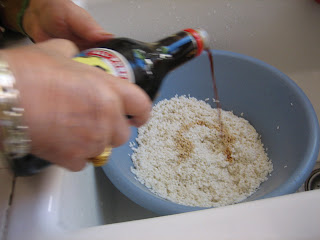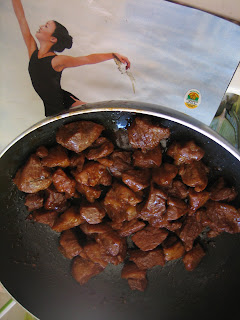*Zongzi is what Marco Polo stole when he came to China and then the Spanish stole from the Italians and brought them over to Mexico, where they became tamales.**
**If you are not Chinese and did not grow up being told every time Italian food was mentioned or ordered that the Italians stole the idea of spaghetti from Chinese chow mein and the idea for pizza from Chinese da bing, then this joke will make no sense to you.
Grandma Hu's Zongzi Recipe (makes 16)
Ingredients
7 cups sticky rice (little plastic rice cups, not big cups!)
Lots (1/2 cup?) of soy sauce
1/4 cup rice wine
cooking oil
salt to taste
1 lb. boneless pork cut into 1.5" cubes***
4 T dried tiny shrimp
4 T dried fried shallots
One polyethelene bag filled with (16) chestnuts
Peanuts or pinto beans or some other bean-shaped thing of your choice
8-10 dried Chinese mushrooms
star anise
guai pi (which might be cinnamon)
bamboo leaves
cotton string cut to 3' lengths
Step 1: Gather Your Ingredients
Since my memory for Chinese names is terrible, I took pictures of everything we did so that I could reconstruct the ingredients when I go hunting around for them in Flushing.

***Once I was vegetarian, but this summer I have become a very poor vegetarian, to the point where I advise the web public on making pork zhong zhi. My excuse is that I am living with my family and the demands of culture outweigh the environmentalism/guilt of Byron****, though that doesn't explain why I stuffed my piehole with a very non-Chinese rotisserie chicken this afternoon while ostensibly "feeding Boo." Anyway, we hunted around for the proper slab of pork to cook and settled for the boneless pork butt, which the handy reference chart above the butcher's station taught me is not from where you and I would consider a pig's butt, but actually from what you and I would call a shoulder. Apparently you can also use wu hua pork, but we didn't.
****Only the Mandarin-speaking among you will understand what "Byron" (say it aloud) refers to.
 Star anise, an integral spice. I think given how strong star anise and the earthy taste of the bamboo leaves are, one might be able to make this recipe vegetarian without losing too much of the flavor. Star anise is called "eight feet" in Chinese because it is an octopod! Not pictured is what my grandma kept calling "guai pi," which a sniff test revealed to be some form of sweet bark, like cinnamon, perhaps cinnamon, but I can't be sure.
Star anise, an integral spice. I think given how strong star anise and the earthy taste of the bamboo leaves are, one might be able to make this recipe vegetarian without losing too much of the flavor. Star anise is called "eight feet" in Chinese because it is an octopod! Not pictured is what my grandma kept calling "guai pi," which a sniff test revealed to be some form of sweet bark, like cinnamon, perhaps cinnamon, but I can't be sure. You can also just buy five spice if you can't find the other spices.
You can also just buy five spice if you can't find the other spices. Fried shallots.
Fried shallots. Some people don't like chestnuts, but then again, some people club baby seals, so you can choose which camp you want to be in when deciding whether to include chestnuts in your zhong zhi.
Some people don't like chestnuts, but then again, some people club baby seals, so you can choose which camp you want to be in when deciding whether to include chestnuts in your zhong zhi.(1) Soak the bamboo leaves overnight in water to make them pliable. You might want to change the water a few times so all of the panda excrement is washed off.
(2) Wash the mushrooms and then soak them in hot water until they are soft. Save the water to add flavor when cooking the pork. Same with the dried tiny shrimps.
Step 2: Prepare the Rice

(15) Bring it all to a boil, then cover and simmer at medium high heat for 35-45 more minutes. You can poke the cubes with a chopstick and if blood squirts all over your face, then the meat is not yet ready. (I'm learning a lot about how to cook meat!) While this is happening, you should watch a very slow-talking Buddhist monk on television read quotes from some offscreen book and try not to fall asleep as your grandma tells you that even though we are Catholic we can learn something from the slow talking Buddhist.
Note: while you are cooking the meat, give the rice a few stirs so that the soy sauce is evenly distributed. The rice should soak up most of the liquid, giving it a nice, even brown color.









3 comments:
just amazing. i love zhong zhi and have grown fairly annoyed with Byron. i will give this a try!
I do not laugh in public embyronments because on the outside I live as a macho, stoic daddy. Muy serio. But the White Man next to me at Think Coffee must be wondering by now what is so frigging hysterical about a pile of cubed pork shoulderbutt and a cleaver. He must think I'm terribly racist, laughing at the gastronomic rituals of a vulnerable yet enduring Eastern peoples. Thank you for this.
and P.S. everyone knows the Cubans invented espaguettis.
are oh why.
Thanks for sharing a Grandma recipe. I've never timed anything by ahmituofuo or ohmannepemehong before. I think I'll try it...
Post a Comment